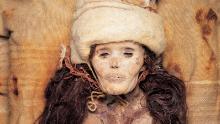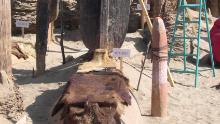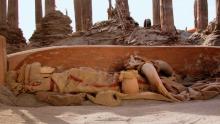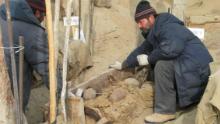DNA reveals unexpected origins of enigmatic mummies buried in a Chinese desert

By Katie Hunt, CNN
Updated 1825 GMT (0225 HKT) October 27, 2021

Photos:
The dry desert air means the bodies are extraordinarily preserved, with hair and facial features clearly visible.
Hide Caption
3 of 5

Photos:
Another aspect of this enigmatic group is that they were buried in boats with oars. The coffin is covered with a cattle hide.
Hide Caption
4 of 5

Photos:
A DNA analysis of the remains suggests that mummies were not newcomers to the region and were descended from Ice Age hunter gatherers.
Hide Caption
5 of 5

Photos:
Hundreds of mummified bodies have been found across the Tarim Basin in Xinjiang, northwestern China, that date back to around 4,000 years ago. This is an aerial view of one site called Xiaohe Cemetery.
Hide Caption
1 of 5

Photos:
The ancestry of the mummies has long been debated among researchers.
Hide Caption
2 of 5

Photos:
The dry desert air means the bodies are extraordinarily preserved, with hair and facial features clearly visible.
Hide Caption
3 of 5

Photos:
Another aspect of this enigmatic group is that they were buried in boats with oars. The coffin is covered with a cattle hide.
Hide Caption
4 of 5

Photos:
A DNA analysis of the remains suggests that mummies were not newcomers to the region and were descended from Ice Age hunter gatherers.
Hide Caption
5 of 5

Photos:
Hundreds of mummified bodies have been found across the Tarim Basin in Xinjiang, northwestern China, that date back to around 4,000 years ago. This is an aerial view of one site called Xiaohe Cemetery.
Hide Caption
1 of 5

Photos:
The ancestry of the mummies has long been debated among researchers.
Hide Caption
2 of 5

Photos:
The dry desert air means the bodies are extraordinarily preserved, with hair and facial features clearly visible.
Hide Caption
3 of 5





(CNN)Since their discovery, the ancestry of hundreds of mummified bodies buried in boats in an inhospitable desert region of northwest China has puzzled and divided archaeologists.
Found in the Tarim Basin in Xinjiang mostly in the 1990s, the mummies' bodies and clothes are strikingly intact despite being up to 4,000 years old. Naturally preserved by the dry desert air, their facial features and hair color can clearly be seen.
Their Western looks; felted and woven wool clothing; and the cheese, wheat and millet found in their unusual graves suggested they were long-distance herders from the West Asia steppe or migrating farmers from the mountains and desert oases of Central Asia.
However, a new study by Chinese, European and American researchers that analyzed the DNA of these 13 mummies, sequencing their genomes for the first time, has painted a different picture. Their analysis suggested that the remains did not belong to newcomers but a local group descended from an ancient Ice Age Asian population.
"The mummies have long fascinated scientists and the public alike since their original discovery. Beyond being extraordinarily preserved, they were found in a highly unusual context, and they exhibit diverse and far-flung cultural elements," said Christina Warinner, an associate professor of anthropology at Harvard University.
"We found strong evidence that they actually represent a highly genetically isolated local population," added Warinner, who is also group leader of microbiome sciences at the Max Planck Institute for Evolutionary Anthropology and an author of the study that published in the journal Nature on Wednesday.
"In contrast to their genetic isolation, however, they seem to have openly embraced new ideas and technologies from their herder and farmer neighbors, while also developing unique cultural elements shared by no other groups," she said.
The researchers looked at the genetic information from the oldest Tarim Basin mummies -- dating from 3,700 to 4,100 years old -- together with genomes sequenced from the remains of five people from the Dzungarian Basin farther north in the Xinjiang Uyghur Autonomous Region in China. Dating back between 4,800 and 5,000 years ago, they are the oldest human remains found in the region.

A naturally mummified Bronze Age woman, who was buried in Xiaohe in the Tarim Basin.
Incredible crossroads
Ancient DNA can provide powerful evidence about the movements of people at a time when written records or other clues are scarce, said Vagheesh Narasimhan, an assistant professor at the University of Texas at Austin, who has worked on genetic samples from the Central Asia region. He wasn't involved in the study, and called the research "exciting."
The research found that the Tarim Basin mummies showed no sign of admixture (a scientific term for having babies) with other groups that lived at the same time. The mummies were direct descendants of a group that was once widespread during the Ice Age but had largely disappeared by the end of that era -- around 10,000 years ago.
Called Ancient North Eurasians, traces of this hunter-gatherer population survive only fractionally in the genomes of present-day populations, with Indigenous people in Siberia and the Americas having the highest known proportions. Finding them in the Tarim Basin and dated to these years was unexpected.
The other genetic samples from farther North in Xinjiang showed that the people they came from mixed extensively with different Bronze Age populations in the region, making it remarkable that the Tarim Basin mummies were so genetically isolated.
While remote now, in the Bronze Age "this was a region of incredible crossroads. There was vibrant mixing of North, South, East and West going back as far back as 5,000 years," said Michael Frachetti, a professor of anthropology at Washington University in Saint Louis, who wasn't involved in the study.
"It makes it all the more paradoxical in a way that you have a community which is heavily integrated from cultural perspectives, but who maintain some very, very iconic and unique components of their own local ideology, local culture, local burial traditions as well as a seemingly unmixed genetic profile that goes back even further into deep time primordial ancestry."
Narasimhan said it was possible for a population to be genetically isolated but also be culturally cosmopolitan.
"It's not necessary for genetics to always go hand in hand with cultural or linguistic exchange," he said. "People can always adopt new techniques be it farming or metal working from other groups, or change their funerary practices and so on, without population movement or turnover."
Unanswered questions
While the DNA study reveals tantalizing details about the mummies,
Frachetti said ancient genetic samples from this region are still relatively rare, and it was possible that they could find other genetic influences from the Himalayas or Tibet.
Although earlier work has shown the mummies lived on the shores of an oasis in the desert, it's still unclear why they were buried in boats covered in cattle hides with oars at their head -- a rare practice not seen elsewhere in the region and perhaps best associated with Vikings.
"They bury their bodies in boats, and no one else does that. That means where that tradition comes from remains one of the biggest enigmas of this desert population, which should be the last community in the world to do this," said Farchetti.



No comments:
Post a Comment